What is Solid Waste Management?
Management of solid waste is the collection, treatment, and disposal of solid material that has served its purpose or is no longer useful. Improper disposal of municipal solid waste can result in unsanitary circumstances, which in turn can lead to environmental contamination and outbreaks of vector-borne diseases, which are transmitted by rodents and insects.
- Solid waste management refers to the process of collecting, treating, and disposing of solid wastes. The waste management process entails the collection, transportation, treatment, analysis, and disposal of wastes from diverse sources.
- It contributes to both water and air pollution, making it a severe global issue. It demonstrates its direct impact on health, economic growth, and environmental damage. It can cause environmental pollution and vector-borne disease outbreaks (diseases spread by rodents and insects).
- Solid trash is a non-liquid, insoluble substance that ranges from municipal garbage to industrial waste and can contain hazardous elements. Domestic waste, sanitary waste, commercial garbage, institutional waste, catering and market waste, biomedical waste, and electronic waste are included.
- Each day, several tonnes of trash are left uncollected on the streets of the majority of emerging cities. It serves as a breeding habitat for bugs that spread disease, clog drains, and cause additional infrastructure problems.
- Due to “rapid urbanisation, population expansion, and economic development,” India’s annual solid waste production is projected to reach 387.8 million tonnes in 2030 and 543.3 million tonnes by 2050.
Harmful Effects of Solid Waste
- a foul odour of garbage
- Production of hazardous gases
- Degradation of natural attractiveness
- Air pollution.
- Water contamination
- Soil contamination.
- Transmission of disease
- Effect on biological diversity.
Categories of Waste
- Organic waste: Kitchen waste, food preparation waste, vegetables, flowers, leaves, and fruits are examples of organic waste.
- Combustibles: Paper, wood, dried leaves, packaging for relief goods, and other combustibles with a high organic content and low moisture level.
- Non-combustibles: Non-combustible materials, such as metal, tins, cans, bottles, rocks, etc.
- Toxic waste: Toxic waste includes expired medications, paints, chemicals, bulbs, spray cans, containers for fertiliser and pesticides, batteries, and shoe polish.
- Recyclables: Paper, glass, metals, plastics.
- Ashes or Dust: The residue left behind by cooking flames.
- Construction waste: Construction waste includes rubble, roofing, and broken concrete, among other materials.
- Hazardous waste: Oil, battery acid, medical waste, industrial garbage, and hospital waste are examples of hazardous waste.
- Animal remains: carcasses of deceased livestock or other species.
- Bulky waste: For example, tree branches and tyres are examples of bulky garbage.
- Soiled waste: Hospital garbage consisting of blood- and other body fluid-stained fabric.
Various Sources of Solid Waste
At several landfills, tonnes of solid garbage are disposed away daily. This trash originates from residences, businesses, industries, and numerous agricultural operations.
These landfills emit a terrible odour if waste is not adequately handled and treated. It can pollute the surrounding air and adversely harm human, animal, and environmental health. The following are major solid waste sources:
1. Residential
- Among the most significant sources of solid waste are inhabited residences and dwellings. Food wastes, plastics, paper, glass, leather, cardboard, metals, yard wastes, ashes, and special wastes such as large home objects such as electronics, tyres, batteries, old mattresses, and used oil make up the garbage from these locations.
- Most households dispose of solid wastes in rubbish containers, which are subsequently emptied by a garbage collection service or individual for treatment.
2. Industrial
- Industries are recognised as one of the largest producers of solid waste. Included are light and heavy manufacturing industries, construction sites, fabrication factories, canning plants, power plants, and chemical plants.
- These industries generate solid waste in the form of food wastes, packaging wastes, ashes, construction and demolition debris, special wastes, medical wastes, and other hazardous pollutants.
3. Commercial
- Today, commercial structures and buildings are another source of solid waste. In this context, commercial structures and facilities relate to hotels, markets, restaurants, warehouses, stores, and office buildings.
- Plastics, food wastes, metals, paper, glass, wood, cardboard, special wastes, and other hazardous wastes are among the solid wastes produced by these locations.
4. Institutional
- Additionally, institutional centres such as schools, colleges, jails, military barracks, and other government facilities generate solid waste.
- Glass, rubber waste, plastics, food wastes, wood, paper, metals, cardboard materials, electronics, and a variety of hazardous wastes are among the common solid wastes collected from these locations.
5. Construction and Demolition Areas
- Additionally, construction and demolition sites contribute to the problem of solid waste. Construction sites include new building and road construction sites, road repair sites, building rehabilitation and demolition sites.
- These locations generate a variety of solid wastes, including steel, concrete, wood, plastics, rubber, copper wires, soil, and glass.
6. Municipal Services
- Urban centres also contribute significantly to the current solid waste crisis in the majority of countries.
- The municipal services that generate solid waste include street cleaning, wastes from parks and beaches, wastewater treatment plants, wastes from landscaping and wastes from recreational areas, including sludge.
7. Treatment Plants and Sites
- Both heavy and light manufacturing facilities generate solid trash. Refineries, power plants, processing facilities, mineral extraction plants, and chemical plants are included.
- These plants generate a variety of trash, including industrial process wastes, undesirable specification products, polymers, and metal parts, to name a few.
8. Agriculture
- Additionally, crop farms, orchards, dairies, vineyards, and feedlots generate solid waste. They create agricultural debris, rotten food, containers for pesticides, and other hazardous stuff.
9. Biomedical
- This refers to hospitals, biomedical equipment manufacturers, and chemical industries. There are various sorts of solid waste created in hospitals.
- These solid wastes consist of syringes, bandages, old gloves, medications, paper, plastics, food wastes, and chemicals, among others. All of them must be disposed of properly, or they will pose a significant threat to the environment and the inhabitants of these sites.
Effects of Poor Solid Waste Management
1. Litter Surroundings
- Due to ineffective trash disposal methods, particularly among municipal waste management teams, wastes accumulate and represent a hazard.
- As individuals clean their homes and workplaces, they trash their surrounds, thereby impacting the environment and the community.
2. Impact on Human Health
- A population’s health may be affected by improper garbage disposal if it resides near a contaminated environment or landfill. In addition, the health of waste disposal workers and other employees associated with these landfills is at increased danger.
- Exposure to badly managed wastes can result in skin irritations, respiratory disorders, blood infections, growth challenges, and even reproductive abnormalities.
3. Disease-causing Pests
- This method of trash disposal causes biodegradable materials to rot and decay in unsanitary, unregulated settings.
- A terrible odour is formed after a few days of decomposition, and it creates a breeding ground for various types of disease-causing insects and pathogenic organisms. In addition, it diminishes the aesthetic value of the place.
4. Environmental Problems
- The industrial solid waste stream is a source of toxic metals, hazardous wastes, and chemicals.
- When solid wastes are released into the environment, they can produce biological and physicochemical problems that can influence or modify the productivity of the soils in that area.
5. Soil and Groundwater Pollution
- Toxic materials and chemicals may seep into the soil and poison the groundwater.
- During the process of collecting solid trash, hazardous wastes generally mix with ordinary rubbish and other flammable wastes making the disposal procedure extra harder and unsafe.
6. Emission of Toxic Gases
- When hazardous wastes such as pesticides, batteries containing lead, mercury, or zinc, cleaning solvents, radioactive materials, e-waste, and plastics combined with paper and other non-toxic scraps are burned, various gases are produced.
- These poisonous gases have the capacity to cause a variety of ailments, including cancer.
7. Impact on Land and Aquatic Animals
- Animals are also negatively impacted by our carelessness with waste and garbage, since they are exposed to the pollutants generated by inappropriate disposal of waste and garbage.
- Marine animals have been shown to perish after consuming Styrofoam and cigarette butts. As the chemicals sink into the soil, grasses consumed by animals near contaminated sites or landfills provide a risk of poisoning.
Municipal Solid Waste
The municipal solid waste consists of everyday items such as product packaging, yard trimmings, furniture, clothing, bottles, cans, food, newspapers, appliances, electronics, and batteries.
As urbanisation and lifestyles evolve, so too does the volume of municipal waste.
It is basically divided into five classes:
- Recyclable Material: Glasses, bottles, cans, paper, metals, etc.
- Composite Wastes include Tetra packs and toys.
- Kitchen garbage, flowers, vegetables, fruits, and leaves are biodegradable wastes.
- Inert Waste includes rocks, garbage, and building materials.
- E-waste, medications, light bulbs, etc. are examples of domestic hazardous and toxic waste.
Municipal solid waste management is necessary for the protection of public health and improvement of environmental quality.
Solid Waste Disposal Methods
There are two methods of Solid Waste Disposal such as;
- On-site disposal options
- Off-site disposal options
A. On-site disposal options
The technical options listed below are broad recommendations for the disposal and storage of garbage on-site; these can be tailored to the specific site and circumstance at hand.
1. Communal pit disposal
- Consumers disposing of rubbish directly into a common pit is arguably the simplest method of solid waste management.
- This pit’s size will depend on how many people it serves.
- The recommended long-term goal is six cubic metres per fifty persons.
- The pit should be surrounded by a fence to prevent little children from falling in, and it should not be more than 100 metres from the residences it serves.
- Ideally, garbage should be covered with a thin layer of dirt at least once each week to reduce the number of flies and other pests.
Advantages
- It may be implemented rapidly and requires minimal operation and maintenance.
Constraints
- The distance to the common pit may result in indiscriminate disposal, and waste management personnel are necessary to manage the pits.
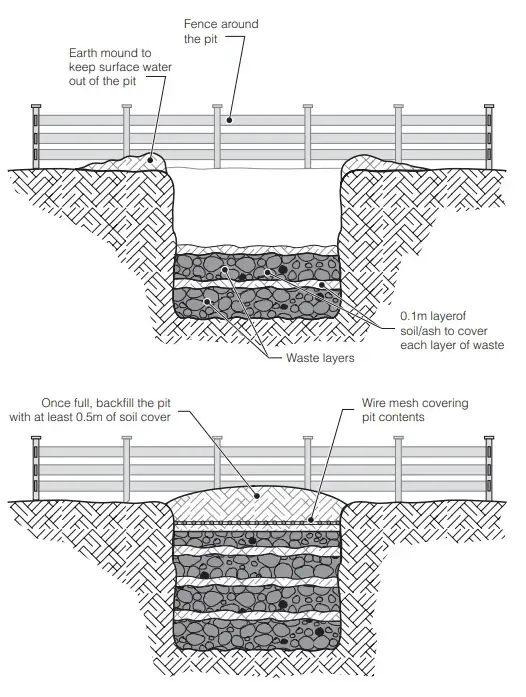
2. Family pit disposal
- Where sufficient room exists, family pits may be the superior long-term alternative.
- These should be somewhat shallow (up to 1 metre deep), and families should be encouraged to cover garbage regularly with soil from sweeping or ash from cooking fires.
- This strategy is optimal if families have vast plots and organic food wastes constitute the majority of household garbage.
Advantages
- Families are responsible for their own trash management; no external garbage employees are necessary; and hygiene awareness programmes can integrate community mobilisation.
Constraints
- Significant community mobilisation is required for the building, operation, and upkeep of pits, and substantial space is required.
3. Communal bins
- The purpose of communal bins or containers is to gather rubbish in a location where it cannot be spread by wind or animals and where it can be conveniently removed for transport and disposal.
- Plastic containers are often unsuitable since they are susceptible to being blown over by the wind, are simple to remove, and may be attractive for other purposes.
- A common option is to give cut-in-half oil drums. The bases of these containers should be pierced to allow liquid to escape and prevent their repurposing.
- If necessary, a lid and handles can be fitted.
- In principle, a single 100-litre bin should be provided for every 50 people in residential areas, 100 people in feeding centres, and 10 market stalls. In general, trash cans should be emptied every day.
Advantages
- Bins have the potential to be a highly hygienic and sanitary system of trash management, with final disposal occurring far from residential areas.
Constraints
- Significant collecting, transportation, and human resources are required; system implementation requires time; and effective management is necessary.
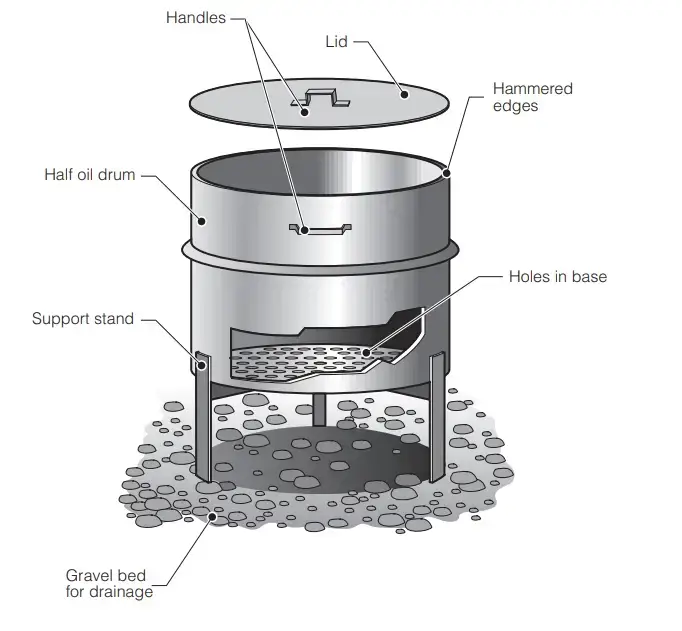
4. Family bins
- In emergency situations, family bins are rarely employed since they require an intensive collection and transportation system, and the quantity of containers or bins required is likely to be substantial.
- In the later phases of a disaster, however, community members can be urged to create their own trash cans and take responsibility for emptying them at communal dumps or depots.
Advantages
- Families are responsible for keeping collection containers as well as a possible hygienic waste management system.
Constraints
- In general, the needed number of bins is excessive; significant collection, transportation, and human resources are necessary; implementation is time-consuming; and efficient management is vital.
5. Communal disposal without bins
- Some public organisations, such as marketplaces and distribution centres, can install solid waste management systems in which customers dispose of waste directly on the ground.
- This will only be successful if cleaners are engaged to periodically sweep the market stalls, collect trash, and take it to an off-site disposal place.
- This may be acceptable for vegetable trash, but butcher waste should be placed in airtight containers and buried separately.
Advantages
- There is less reliance on the activities of users, and the system may be consistent with customary/common practise.
Constraints
- Management must be efficient and effective, and full-time trash workers must be employed.
B. Off-site disposal options
1. Landfilling
- Once solid trash has been moved off-site, it is often deposited in a landfill. Here, garbage is deposited in a big excavation (pit or trench) in the earth, which is backfilled daily with dug soil. Each day’s trash should ideally be covered with around 0.5 metres of soil to prevent animals from rummaging through it and flies from reproducing.
- The location of landfills should be determined through collaboration with the affected people and local authorities.
- Preferably, sites should be fenced and at least one kilometre downwind of the nearest residences.
Advantages
- A sanitary disposal method if properly managed.
Constraints
- A sufficiently spacious region is required.
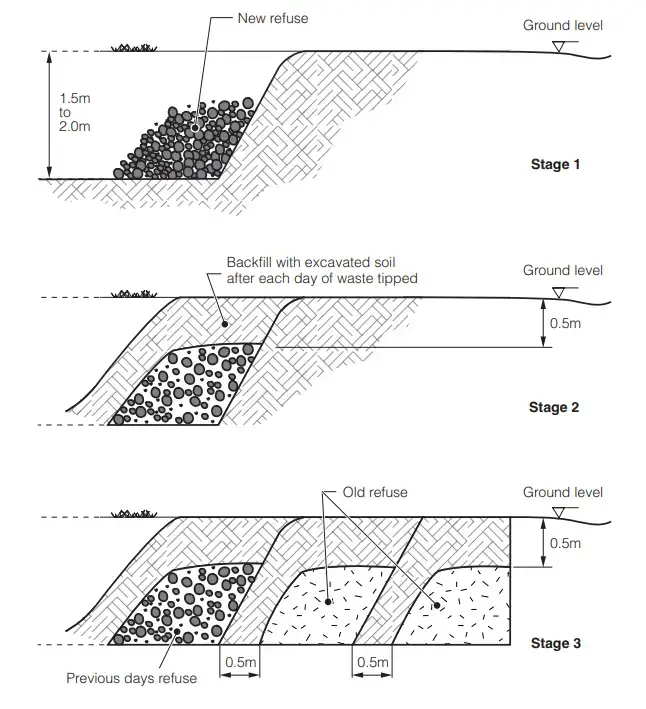
Types of Landfilling
Based on the type of pit utilised, the landfill method can be split into two categories:
- Cell emplacement and
- Trench method or ‘cut and fill’ method.
A. Cell Emplacement Method
- In this procedure, cells of acceptable size are excavated to a depth of 2.5 metres at the landfill site, the size of the cells being determined by the daily amount of waste to be dumped.
- Each day, the garbage put in the cell is compacted and covered with a layer of earth around 20 centimetres thick. The cells can be built with one or more layers.
- A single-layered cell is completely stuffed with the solid waste of one day and then covered with dirt.
- Each day, the waste is compacted and covered with 30 to 40 centimetres of soil, and when the cell is full, it is covered with a 60 to 90 centimetre layer of dirt.
B. Trench Method
- In this technique, lengthy trenches are dug, filled with rubbish, and then covered with dirt. In both cell emplacement and trench procedures, dirt is excavated from the site of the next trench/cell to bury the waste.
- However, since only roughly 20% of the cell/trench volume is occupied by soil, 80% of the dirt excavated from the second and subsequent cells/trenches must be removed, unless the landfill site elevation is increased above ground level.
Hazards of Landfill
There are a number of risks associated with the dumping of trash in landfills, including the possibility of fires starting in the waste piles.
- Population growth of disease vectors such as flies.
- Offensive smells.
- Leakage of methane.
- Leaching of hazardous and caustic substances into surface and subsurface waters.
The leachate from landfills may have 6000-7000 mg/l total solids, 1000-2000 mg/l COD, and 800 mg/l sodium, whereas the outflow from landfills may contain 1000-2000 mg/l total solids, 70-80 mg/l COD, and 300 mg/l sodium. The risks of fires, disagreeable odours, and increasing vector populations can be avoided by covering garbage daily with soil.
The threat posed by methane can be eliminated through combustion or tapping. Similarly, environmental damage caused by landfill leachate can be prevented by lining the pit with an impermeable substance, such as clay, soil-cement combinations, concrete, polymeric compounds, or asphalts. However, the long-term containment of some linings, such as clay, is unclear. Therefore, it is desirable to minimise the toxicity of the wastes using specialised pretreatments.
2. Incineration
- Although burning or incineration is commonly employed to dispose of combustible garbage, it should normally only occur off-site or at a substantial distance downwind from inhabited areas.
- Burning garbage in residential areas may provide a substantial smoke or fire threat, especially if multiple fires are ignited.
- When there is little space for burial or landfilling, it may be beneficial to minimise the volume of garbage through combustion.
- Similar to landfilling, waste should be burned in pits and then covered with earth after incineration. The same criteria that govern the placement of landfills should be applied here as well.
Advantages
- Burning significantly reduces the volume of combustible garbage, and thus is suited for use in off-site pits to reduce scavenging.
Constraints
- There may be fire and smoke hazards.
3. Composting
- Composting is a substrate-dense, self-heating, regulated microbial system and one solid-phase biological treatment technology.
- This method is suitable for treating huge quantities of contaminated solids. However, due to their complicated chemical structure, toxicity, and low component concentration, numerous dangerous chemicals are resistant to microbial breakdown.
- Additionally, moisture, pH, inorganic nutrients, and particle size affect microbial development. Since composting of hazardous wastes often entails bioremediation of contaminated substrate-sparse soils, supplementation is required to enable microbial self-heating.
- Aliphatic and aromatic hydrocarbons, as well as a few halogenated chemicals, are among the dangerous substances that reportedly vanish after composting.
- Volatilization, assimilation, adsorption, polymerization, and leaching are all conceivable mechanisms that lead to the elimination of dangerous chemicals.
- Composting can be performed in both open and closed systems, such as land treatment. The open land system can be a cost-effective form of treatment, however the temperature varies from summer to winter.
- Therefore, the rate of waste biodegradation decreases. Depending on the quantity of substrate, the depth of waste, the application, etc., a land treatment system may become oxygen-limited.
- However, flowing air can boost the effectiveness of open treatment systems. This technique is known as designed soil piles and forced aeration therapy. Because controlled air is given to maintain microbial activity, the closed treatment system is preferable over the open land treatment system.
- The interior temperature steadily rises due to the growth of microorganisms and the volatilization of dangerous substances.
- Therefore, closed treatment systems employ blowers for air circulation and exhaust for the elimination of hazardous volatiles. Ventilators provide oxygen and remove heat through water evaporation.
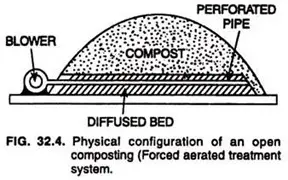
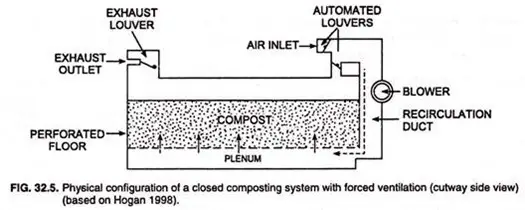
Process of Composting
- As composting is a solid-phase biological treatment, the target chemicals must be solid or liquids coupled with solid matrices. The harmful chemicals should be converted biologically.
- To attain this objective, waste should be appropriately prepared to optimise its potential for biological treatment. This is accomplished by adjusting a number of physical, chemical, and biological parameters.
- The hazardous wastes must be effectively solubilized to be bioavailable. Microorganisms derive their carbon and energy from toxic chemicals and soil organic materials.
- During the development phase, microorganisms release enzymes that breakdown harmful substances. However, proper waste management. Oxygen, inorganic nutrients, and pH all accelerate decomposition.
- Compost can be supplemented with analogue or non-analogue, non-hazardous carbon sources that boost microbial growth and enzyme synthesis in the presence of low substrate density or site-specific circumstances. Organic amendments also stabilise the population of microorganisms in an inhibitive environment.
- Secondly, an adequate amount of water promotes microbial development. The addition of inorganic fertilisers affects the microbial growth and breakdown rate of hazardous waste.
- Phanerochaete chrysosporium develops extracellular lignin peroxidase that degrades benzopyrene and 2, 4, 6-trinitrotoluene under nitrogen-limiting circumstances.
- It has also been shown that a pH range between 5.0 and 7.8 facilitated the highest rates of hazardous waste breakdown. However, lignin breakdown was shown to occur quickest at pH levels between 3.0 and 6.5. This demonstrates that ideal pH values can vary by species, location, and waste type.
- Indigenous microflora gradually colonises organic materials, however toxic substances may limit microbial growth.
- Therefore, bioaugmentation (i.e., the use of commercial or genetically engineered microbes, or GEMs) of wastes is also suggested.
- To give experimental evidence of biodegradation during composting, 14C-labelled Carbaryl was introduced to a mixture of sewage sludge and wood chips at a concentration of 1.3 to 2.2 ppm.
- After 18 to 20 days in laboratory composting equipment, 1.6 to 4.9% of carbaryl was recovered as 14CO2 and bonded to soil organic matter.
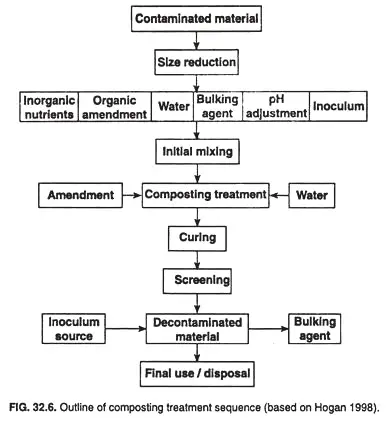
Advantages
- Composting is helpful for plants and environmentally friendly.
Constraints
- Operations on a high scale necessitate intensive management and a skilled workforce.
4. Recycling
- Complex recycling systems are unlikely to be applicable, but it may be possible to recycle certain waste goods on occasion.
- In many instances, plastic bags, containers, tins, and glass will be recycled automatically because they are considered to be rare resources.
- In the majority of underdeveloped countries, there is a strong tradition of recycling, resulting in less waste than in many more affluent civilizations.
Advantages
- Recycling is good for the environment.
Constraints
- There is limited potential in the majority of emergency circumstances, and installation is costly.
5. Vermicomposting
- Vermicomposting is the process by which earthworms produce compost. Clearly, earthworms play a crucial part in the cycle of plant nutrients, the turnover of organic matter, and the preservation of soil structure. Daily, the earthworms can consume 10-20% of their own biomass.
- The greatest impact of earthworms on agroecosystems is the enhancement of nutrient cycling, notably nitrogen. They consume organic matter with a high C:N ratio and transform it into earthworm tissue with a lower C:N ratio. Thus, they impact the soil’s physical and chemical qualities.
- Numerous nations, including our own, have made substantial contributions to this field. Using earthworms, scientists at the Indian Institute of Sciences (Bangalore) have discovered ways for the frequent degradation of coconut coir.
- Prof. B.R. Kaushal and his colleagues at Kumaun University, Nainital, have conducted extensive research on earthworms, their food materials, food habits, and organic matter turnover, and have established relationships between earthworms’ food consumption, changes in their work biomass, and casting activity.
- In laboratory cultures, these individuals have also observed the feeding and oviposition behaviour of Amuynthas alexandri on corn, wheat, and mixed grasses. The surface and sides of the containers were casted. Dietary intake ranged from 36 to 69 mg/g of live worm per day. Daily cast generation varied between 4 and 6 mg/g of live worm.
- Some of the known and probable waste decomposer earthworms (such as Drawidia nepalensis, etc.) may be introduced in their absence. Kausal and Bisht (1992) investigated the development and cocoon generation of D. nepalensis on cow and horse manure devoid of urine. D. nepalensis is a slow-growing vermicomposting and parthenogenetic species.
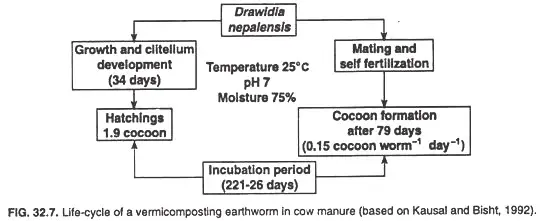
6. Pyrolysis
- Under anaerobic conditions, this is destructive distillation. Some solid wastes are treated to combustion at a temperature of 1,650°C, in the absence of oxygen, during this procedure. As triproducts, a range of hydrocarbons and gases such as CO2 or CO are produced.
- This technique is most useful in urban areas where many tonnes of solid garbage are collected daily and there is limited room to dispose of them.
7. Dumping
This is another method of solid waste disposal that can be accomplished in the subsequent ways:
a. Open dumping
- During this procedure, solid wastes are dumped in vast, unpopulated areas.
- Periodically, they are burned and compacted to minimise volume and generate place for further dumping.
b. Sanitary landfill
- These are uninhabited natural landscapes characterised by depressions or trench-like places. The garbage is deposited in them in successive layers, squeezed and compacted, then covered with soil.
- As a result of land filling, the resulting surface can be used for sports grounds, animal grazing fields, and even houses.
c. Ocean dumping
- In a number of affluent nations, including the United States, France, and the United Kingdom, domestic and industrial solid wastes are dumped in the ocean.
- In 1970, an estimated sixty million tonnes of garbage were dumped into the ocean at over two hundred disposal sites in the United States alone.
- As a result of their negative impact on marine wildlife and navigation, this practise is increasingly declining.
References
- https://www.britannica.com/technology/solid-waste-management
- https://www.unep.org/explore-topics/resource-efficiency/what-we-do/cities/solid-waste-management
- https://www.wburbanservices.gov.in/upload_file/guidlines/swm_guideline.pdf
- https://ec.europa.eu/echo/files/evaluation/watsan2005/annex_files/WEDC/es/ES07CD.pdf
- https://www.conserve-energy-future.com/sources-effects-methods-of-solid-waste-management.php
- https://cpcb.nic.in/uploads/MSW/Action_plan.pdf
- https://datatopics.worldbank.org/what-a-waste/trends_in_solid_waste_management.html
- https://www.kmcgov.in/KMCPortal/jsp/SolidWaste.jsp
- https://en.wikipedia.org/wiki/Waste_management
- https://www.vedantu.com/biology/solid-waste-management
- http://jkspcb.nic.in/Content/Municipal.aspx?id=320
- https://www.adb.org/sites/default/files/publication/652121/adbi-pb2020-7.pdf
- https://mohua.gov.in/upload/uploadfiles/files/Part2.pdf
- https://www.worldbank.org/en/topic/urbandevelopment/brief/solid-waste-management
- Text Highlighting: Select any text in the post content to highlight it
- Text Annotation: Select text and add comments with annotations
- Comment Management: Edit or delete your own comments
- Highlight Management: Remove your own highlights
How to use: Simply select any text in the post content above, and you'll see annotation options. Login here or create an account to get started.